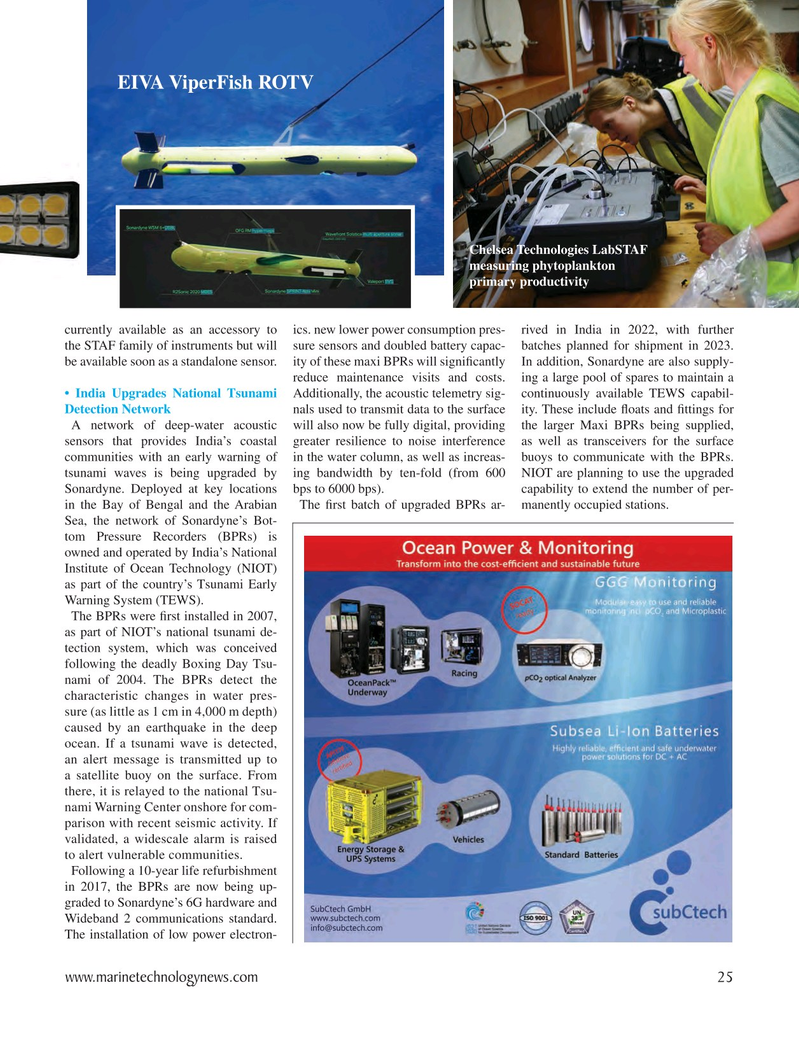
Page 25: of Marine Technology Magazine (May 2023)
Read this page in Pdf, Flash or Html5 edition of May 2023 Marine Technology Magazine
EIVA ViperFish ROTV
Chelsea Technologies LabSTAF measuring phytoplankton primary productivity currently available as an accessory to ics. new lower power consumption pres- rived in India in 2022, with further the STAF family of instruments but will sure sensors and doubled battery capac- batches planned for shipment in 2023. be available soon as a standalone sensor. ity of these maxi BPRs will signi? cantly In addition, Sonardyne are also supply- reduce maintenance visits and costs. ing a large pool of spares to maintain a • India Upgrades National Tsunami Additionally, the acoustic telemetry sig- continuously available TEWS capabil-
Detection Network nals used to transmit data to the surface ity. These include ? oats and ? ttings for
A network of deep-water acoustic will also now be fully digital, providing the larger Maxi BPRs being supplied, sensors that provides India’s coastal greater resilience to noise interference as well as transceivers for the surface communities with an early warning of in the water column, as well as increas- buoys to communicate with the BPRs. tsunami waves is being upgraded by ing bandwidth by ten-fold (from 600 NIOT are planning to use the upgraded
Sonardyne. Deployed at key locations bps to 6000 bps). capability to extend the number of per- in the Bay of Bengal and the Arabian The ? rst batch of upgraded BPRs ar- manently occupied stations.
Sea, the network of Sonardyne’s Bot- tom Pressure Recorders (BPRs) is owned and operated by India’s National
Institute of Ocean Technology (NIOT) as part of the country’s Tsunami Early
Warning System (TEWS).
The BPRs were ? rst installed in 2007, as part of NIOT’s national tsunami de- tection system, which was conceived following the deadly Boxing Day Tsu- nami of 2004. The BPRs detect the characteristic changes in water pres- sure (as little as 1 cm in 4,000 m depth) caused by an earthquake in the deep ocean. If a tsunami wave is detected, an alert message is transmitted up to a satellite buoy on the surface. From there, it is relayed to the national Tsu- nami Warning Center onshore for com- parison with recent seismic activity. If validated, a widescale alarm is raised to alert vulnerable communities.
Following a 10-year life refurbishment in 2017, the BPRs are now being up- graded to Sonardyne’s 6G hardware and
Wideband 2 communications standard.
The installation of low power electron- www.marinetechnologynews.com 25
MTR #4 (18-33).indd 25 6/1/2023 12:55:05 PM

 24
24

 26
26
